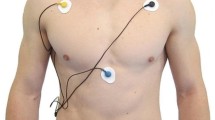Abstract
This study explored how the clinicians'/experimenters' breath patterns affected subjects' inhalation volume. 20 volunteer subjects inhaled 20 sequential breaths (10 normal and 10 paced) with their eyes closed. During the paced exhalation, the experimenter audibly exhaled in phase with the subjects' exhalation. The subjects's inhalation volumes significantly increased during the paced as compared to the initial normal breathing phase, F(1,19)=8.82, p<.01, repeated measures ANOVA. These findings confirm that the clinician's breathing style directly affects the client's breath pattern.
Similar content being viewed by others
References
Fried, R. (1987).The hyperventilation syndrome. Baltimore: John Hopkins University Press.
Goldstein, A. P. (1971).Psychotherapeutic attraction. New York: Pergamon.
Peper, E., & MacHose, M. (1990). Imagery pollution: The effect of imagery on inhalation volume.Proceedings of the Twenty-First Annual Meeting of the Association for Applied Psychophysiology and Biofeedback. Wheat Ridge, CO: AAPB, pp. 149–152.
Peper, E., & Sandler, L. (1987). The meta communications underlying biofeedback training.Clinical Biofeedback and Health, 10(1), 37–42.
Peper, E., & Tibbetts, V. (1992). 15-month follow up with asthmatics utilizing EMG/Incentive inspirometer feedback.Biofeedback and Self-Regulation, 17 143–151.
Roland, M., & Peper, E. (1987). Inhalation volume changes with inspirometer feedback and diaphragmatic breathing coaching.Clinical Biofeedback and Health, 10(2), 89–97.
Schellenberger, R., & Green, J. A. (1986).From the ghost in the box to successful biofeedback training. Greeley, CO: Health Psychology Publications.
Taub, E. (1977). Self-regulation of human tissue temperature. In G. Schwartz & J. Beatty (Eds.).Biofeedback theory research. New York: Academic Press.
Tibbetts, V., & Peper, E. (in press). Incentive inspirometer feedback for desensitization with asthmatic provoking triggers: A clinical protocol.Medical Psychotherapy.
Tiep, B. L. (1991). Reversing disability of irreversible lung disease. Western Journal of Medicine,154 591–597.
Author information
Authors and Affiliations
Rights and permissions
About this article
Cite this article
Tibbetts, V., Peper, E. The effects of therapist breathing style on subject's inhalation volumes. Biofeedback and Self-Regulation 18, 115–120 (1993). https://doi.org/10.1007/BF01848112
Issue Date:
DOI: https://doi.org/10.1007/BF01848112




